在惰性有毒有机物的处理中, 高级氧化技术以其降解的高效性和彻底性而受到人们的重视, 臭氧类高级氧化技术即是其中的一种重要方法[1~7].在众多的臭氧类高级氧化技术中, 非均相催化臭氧化技术又以操作的简便性而得到人们的青睐[8, 9].当前非均相催化臭氧化技术报道的催化剂大多以一些Lewis acids为主, 比如一些过渡金属氧化物MnO[10]2、NiO[11]、Co3O[12]4、Ag2O[13]、CeO[14]2等, 对于固体碱催化剂的报道较少. MgO作为典型固体碱催化剂在很多催化领域已有应用, 比如醇类的脱氢反应[15]、催化降解有机物等[16~19].在臭氧化领域, Moussavi等[16]利用沉淀法制备了MgO, 并利用其催化臭氧降解了红色198偶氮染料.然而他们没有考虑MgO对溶液pH的影响, 也没有考虑降解过程pH的变化情况, 不利于催化作用机制的澄清[20~25].
本文以活性炭为载体(GAC)[26~28], 利用浸渍法制备了MgO/GAC-1催化剂, 考察了其在臭氧化乙酸(臭氧惰性小分子有机物的代表)和敌草隆(芳环类化合物的代表, 臭氧化降解过程pH变化较大)的性能, 重点分析了MgO/GAC-1对臭氧化过程溶液pH的变化情况, 并与臭氧化效率进行关联, 以便更好地解析其作用机制.此外, 本研究中还从稳定性的角度对比了所制备的催化剂与Moussavi等[19]报道的MgO/GAC-2催化剂.
1 材料与方法 1.1 材料与试剂乙酸、敌草隆、六水合硝酸镁为分析纯, 甲醇为色谱纯, 其他试剂均为分析纯, 使用前不经过前处理.活性炭为圆柱状, 其他溶液均用二次去离子水配置, 溶液pH用1.0 mol ·L-1硫酸和1.0 mol ·L-1氢氧化钠调节.
1.2 实验装置本研究中所有实验采用的是半连续的方式进行, 实验装置(图 1)臭氧发生器和破坏器的型号为CFS-1A和ODF-003 (Ozonia, Switzerland), 臭氧反应器(高为75 cm, 内径为5 cm)为一带恒温夹套的玻璃反应器, 布气装置为反应器底部的砂芯, 所有的实验均在室温条件下进行.每次实验, 模拟废水为500 mL的乙酸或敌草隆溶液.在臭氧化乙酸中, 乙酸浓度100 mg ·L-1, 氧气流量0.67 L ·min-1, 臭氧产量为46.9 mg ·min-1; 在臭氧化敌草隆中, 敌草隆浓度为25 mg ·L-1, 氧气流量为0.1 L ·min-1, 臭氧产量为9.0 mg ·min-1.尾气中的臭氧用2%碘化钾溶液吸收.
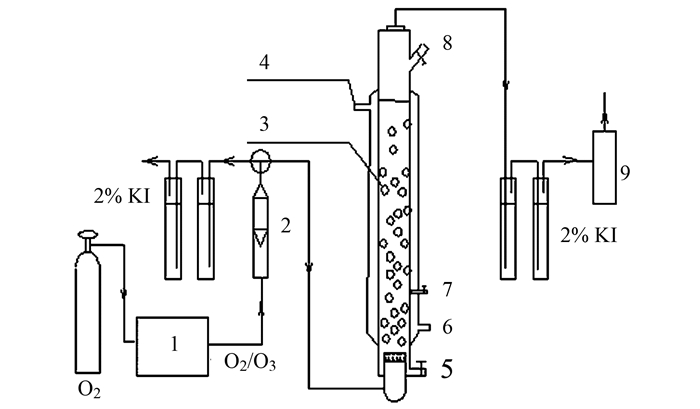
|
1.臭氧发生器; 2.流量计; 3.臭氧反应器; 4.循环水出口; 5.出料口; 6.循环水进口; 7.取样口; 8.进料口; 9.臭氧破坏器 图 1 实验装置示意 Fig. 1 Diagram of the experimental setup |
采用浸渍法制备MgO/GAC-1.将4.27 g Mg(NO3)2 ·6H2O溶解于水中, 再加入10 g活性炭, 12 h的浸渍后, 催化剂在100℃下干燥24 h, 最后在N2氛围下煅烧4.0 h.根据文献[19]利用沉淀法制备了MgO/GAC-2, 步骤如下:先将5.0 g Mg (NO3)2 ·6H2O溶解于50 mL水中, 然后加入3.0 mL的NaOH (1.0 mol ·L-1), 在搅拌条件下形成凝胶状物质, 加入10 g GAC浸渍30 min, 再把催化剂干燥煅烧生成MgO/GAC-2.
1.4 分析方法乙酸浓度采用的是HPLC(ThermoFisher Dionex Ultimate3000, USAHypesil gold C18)色谱柱(250×4.6 mm, 粒径5 μm).流动相为0.013 4 mol ·L-1的磷酸缓冲液(pH=3) :甲醇(950 :50, 体积比).流速为1.2 mL ·min-1, 紫外检测波长为210 nm, 柱温为25℃.敌草隆浓度采用的是HPLC, 流动相为乙腈:水(6 :4, 体积比), 流速为0.5 mL ·min-1, 紫外检测器波长254 nm, 柱温30℃.催化剂物相采用X射线仪(XRD)分析, 测定X射线为Cu靶Kα射线(λ=0.154 2 nm).管电压45 kV, 管电流为40 mA, 扫描范围10°~80°.采用扫描电子显微镜(SEM)检测颗粒的形态, 用BET检测了样品的比表面积, 利用二氧化碳吸/脱附等温线分析了催化剂表面的碱性位强度和数量.
2 结果与讨论 2.1 催化剂的表征XRD分析结果表明(图 2), 36.943°、42.920°、62.315°(JCPD45-0946)是MgO的特征峰, 分别对应的是(111)、(220)、(322)晶面, 说明本方法成功将MgO负载在活性炭上.在BET的测试中, MgO/GAC-1的比表面积为612.23 m2 ·g-1, MgO/GAC-2的比表面积为740.10 m2 ·g-1.两者差别的原因可能是Mg(OH)2凝胶法形成的MgO多数在GAC的表面, 而MgO/GAC-1会进入到活性炭的孔道中, 使得MgO/GAC-2比MgO/GAC-1的比表面积大.
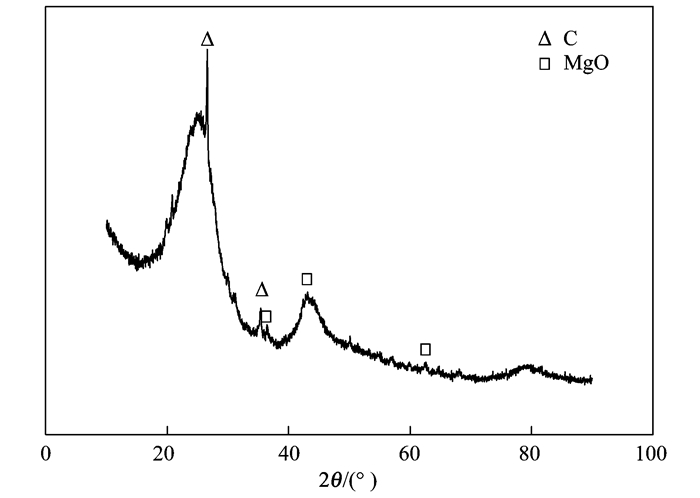
|
图 2 MgO/GAC的XRD图 Fig. 2 XRD pattern of MgO/GAC |
在SEM的表征图中可以看到(图 3), 在放大倍数10.0×103的条件下, 图 3(a)中的活性炭表面有较多的空穴, 凹凸不平; 而MgO/GAC-1表面更细致并有一些小颗粒, 说明MgO负载在了活性炭的表面, 图 3(b)部分填补了活性炭的表面空穴位置.图 3(c)中的MgO/GAC-2样品活性炭的表面出现了很多针状物质, 可能生成的Mg(OH)2胶体很难进入活性炭的孔道内部, 导致MgO基本存在于活性炭的表面.
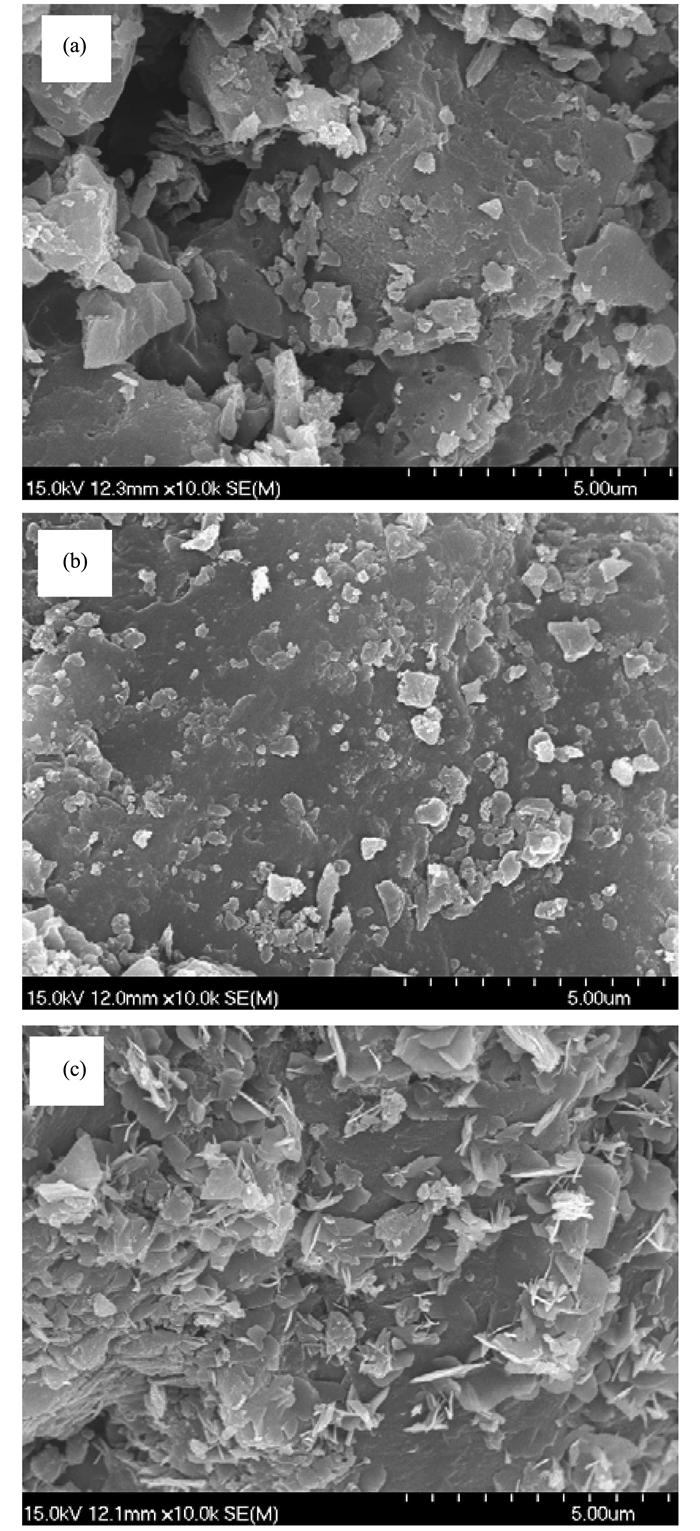
|
(a) GAC, (b) MgO/GAC-1, (c) MgO/GAC-2 图 3 催化剂的SEM图 Fig. 3 SEM of the catalyst (a. GAC, b. MgO/GAC-1, c. MgO/GAC-2) |
图 4为催化剂的CO2脱附.相对于MgO/GAC-1, MgO/GAC-2碱性位略强[29], 但从峰面积可以看出MgO/GAC-1比MgO/GAC-2的碱性位数目更多.以上差异预示两者在臭氧化过程中的性能可能会有些差异.
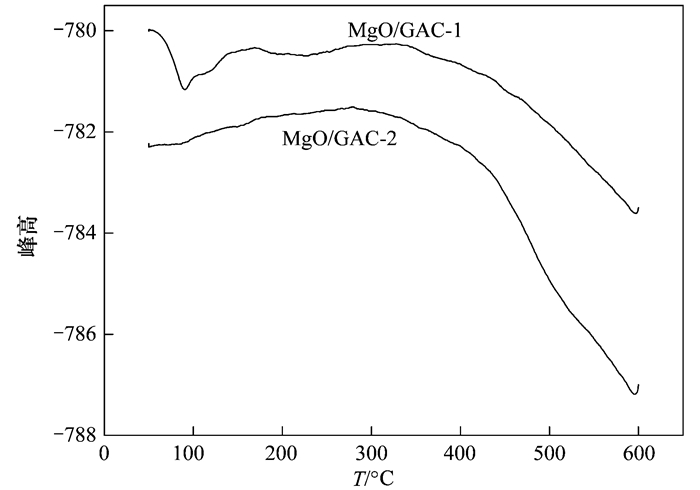
|
图 4 两种催化剂的CO2-TPD的图谱 Fig. 4 CO2-TPD graphics of the two catalysts |
pH是影响臭氧化效率的一个重要因素, 图 5为不同初始pH条件下臭氧及催化臭氧化敌草隆过程pH的变化情况.当初始pH为5.0和7.0时, 由于中间产物小分子有机酸的形成, 单独臭氧化过程溶液的pH不断下降, 15 min后溶液的pH下降3.5左右.但在MgO/GAC-1/O3中, 溶液pH在前10 min时pH变化至6.3后基本稳定不变, 初始pH为5.0时溶液的pH值反而升高了.当初始pH为9.0时, 单独臭氧下pH在15 min后降到7.5, 而催化臭氧化过程20 min后pH下降到8.5后就基本稳定了, 说明MgO/GAC-1有效抑制了反应液pH的下降.当pH为11.0时, 两者均会导致溶液pH的明显下降, 但相比单独臭氧化, 催化臭氧化过程pH的下较缓慢, 30 min后要比单独臭氧化的pH约高一个单位, 并维持在8.5左右.臭氧化水处理中, 一般较高的pH值有利于提高臭氧化效率.降解实验的结果表明(图 6), 加入MgO/GAC-1可以明显提高臭氧化的效率, 在不同初始pH条件下臭氧化的效率提升幅度为15%~35%.吸附实验表明, 当pH为5.0和7.0时, MgO/GAC-1对敌草隆的吸附去除率只有1.0%, 当pH为9.0和11.0时, MgO/GAC-1对敌草隆的吸附效果约为5.0%, 均明显小于催化臭氧化条件下去除率的提高.
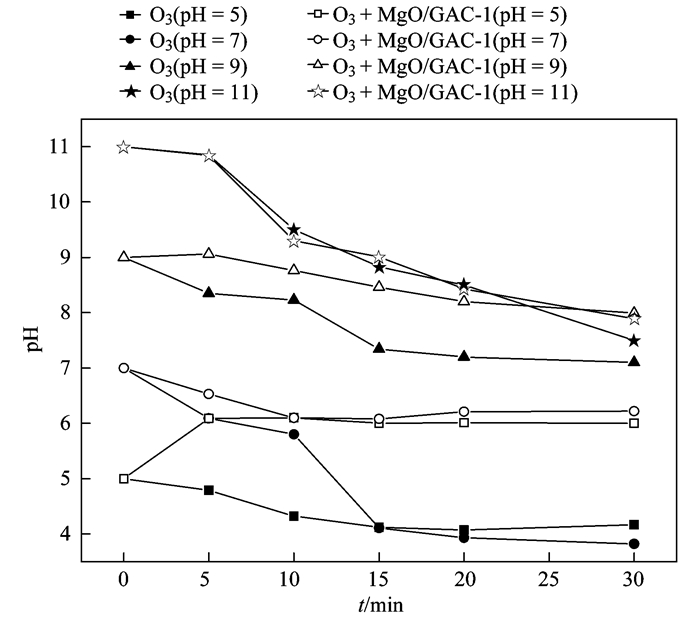
|
图 5 臭氧及MgO/GAC-1催化臭氧化降解敌草隆过程中pH的变化 Fig. 5 Evolution of the pH value of the diuron solution via O3 and MgO/GAC-1 at different initial pH values |
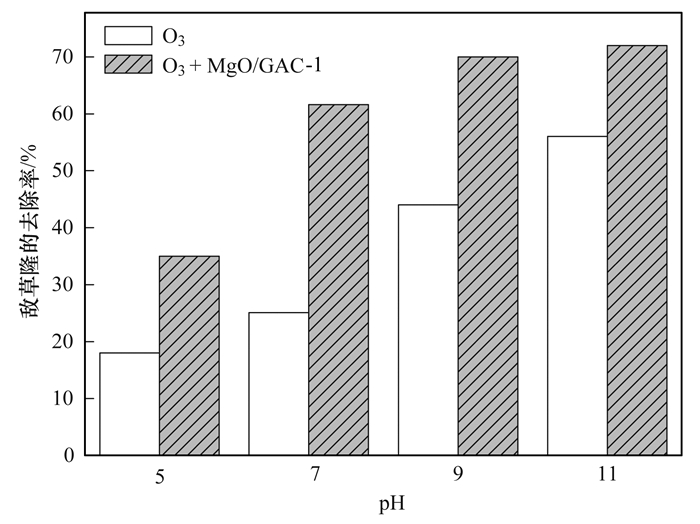
|
图 6 不同初始pH条件下臭氧及MgO/GAC-1催化臭氧化敌草隆的效率 Fig. 6 Removal rates of diuron via O3 and MgO/GAC-1 at different initial pH values |
由此可见, 在不同pH溶液中, MgO/GAC-1在一定程度上能提高或减缓了溶液的pH变化, 从而提高臭氧化敌草隆的效率.
2.3 臭氧化降解乙酸与敌草隆相比, 乙酸本身是一种小分子有机酸, 其在臭氧化降解的过程中pH值不会有较大的变化.图 7结果表明, 尽管pH的变化幅度有所减缓, 但无论是在酸性条件还是在中碱性条件, MgO/GAC-1仍然实现了提升溶液pH或减缓pH下降的目的.如在pH为5.0时, 由于乙酸为臭氧惰性物, 故单独臭氧化过程溶液的pH几乎不变; 但在MgO/GAC-1催化臭氧过程中, 溶液pH一直缓慢上升, 30 min后达到6.0.当初始pH为7.0和9.0时, 单独臭氧和催化臭氧化过程均会导致溶液pH的下降, 10 min后MgO/GAC-1/O3过程溶液pH维持在7.5左右, 而单独臭氧过程pH下降至7.0左右.当pH为11.0时, 与单独臭氧化相比, MgO/GAC-1/O3过程pH下降得慢, 20 min后两者差0.5左右.图 8为在不同初始pH条件下臭氧与催化臭氧化条件下乙酸的去除率.除pH为11.0外, MgO/GAC-1能使臭氧化的效率提升约10%~30%. MgO/GAC-1的吸附实验表明, 在所有初始pH条件下MgO/GAC-1对于乙酸的吸附效果约为6.5%左右.在pH=11.0时, 两者对乙酸的去除率几乎相同, 这可能是由于在较高pH条件下单独臭氧就能产生较多的羟基自由基, 因此MgO/GAC-1的加入作用不明显[30~32].
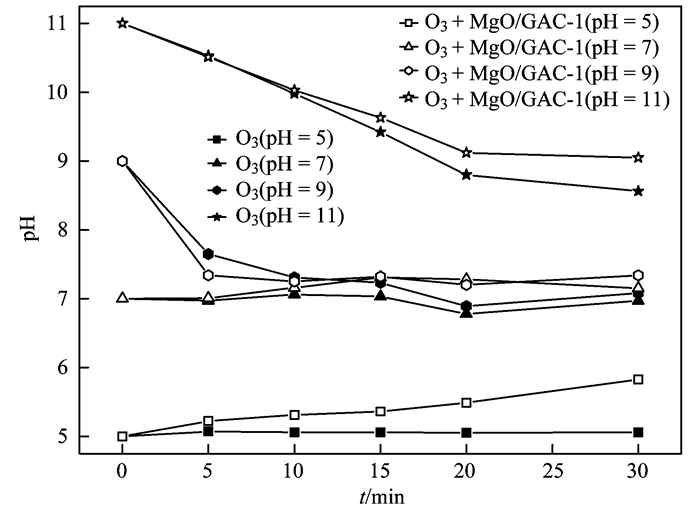
|
图 7 臭氧及MgO/GAC-1催化臭氧化降解乙酸过程中pH的变化 Fig. 7 Evolution of the pH values of the acetic acid solution via O3 and MgO/GAC-1 at different initial pH values |
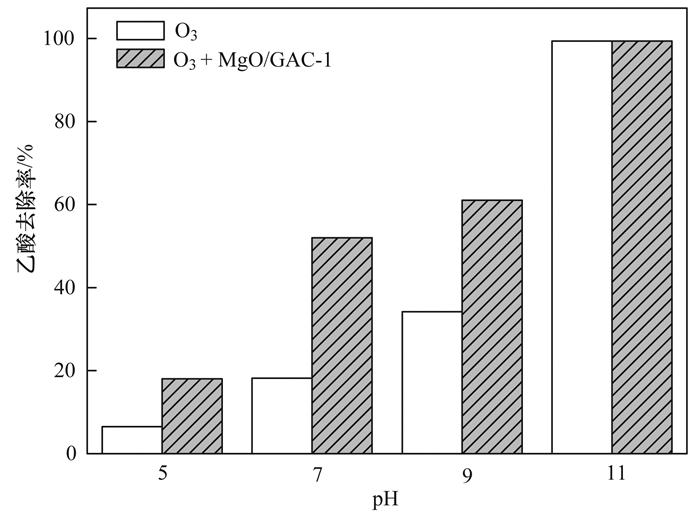
|
图 8 不同初始pH条件下臭氧及MgO/GAC-1催化臭氧化乙酸的效率 Fig. 8 Removal rates of acetic via O3 and MgO/GAC-1 at different initial pH values |
以上结果表明, MgO/GAC-1催化臭氧化降解有机物的本质机制是MgO/GAC-1可以有效提升或减缓溶液的pH值, 从而保证臭氧化过程在适宜的pH值下进行.这也是MgO/GAC-1能有效提高臭氧化效率的主要原因[33, 34].在已有氧化镁催化臭氧化有机物的报道中, 作者只是以有机物和COD去除率的提高说明MgO/GAC-2能催化臭氧产生羟基自由基, 基本没有涉及降解过程溶液pH的变化情况, 这显然不利于其作用机制的澄清.
2.4 催化剂稳定性研究Wang等[35]报道了经真空处理的氧化钙和氧化镁对于1-丁烯异构化反应具有非常高的催化活性, 此研究清楚地指出碱催化剂制备和预处理方法的重要性.为此工作中对不同方法制备活性炭载氧化镁的活性和稳定性进行了分析.结果发现(图 9), 利用浸渍法制备的MgO/GAC-1在重复使用10次后仍然具有较好的催化活性, 乙酸的去除率基本稳定在45%左右.与MgO/GAC-2相比, 整个实验过程MgO/GAC-1也具有更高的活性和更好的稳定性.平均而言, MgO/GAC-1/O3对乙酸的去除率要比MgO/GAC-2/O3高5.0%左右.这主要是因为浸渍法能使盐类充分地进入到孔道里面, 而且沉淀法制备的MgO/GAC-2催化剂, MgO更多的负载在GAC的表面, 从而影响催化剂活性和使用寿命[36].
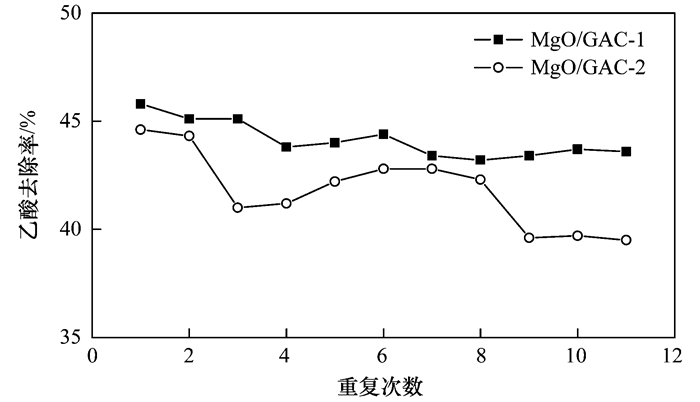
|
图 9 MgO/GAC-1和MgO/GAC-2稳定性的对比 Fig. 9 Comparison of stability between MgO/GAC-1 and MgO/GAC-2 |
(1) 当溶液初始pH为中性或碱性时, MgO/GAC-1可以有效减缓由于小分子有机酸形成而导致pH的下降问题; 当溶液初始pH为酸性时, 其在一定程度上可以提升溶液的pH值.结合相应敌草隆和乙酸的降解结果, MgO/GAC-1对溶液pH值的调整作用可能是臭氧化效率提高的主要原因.
(2) 在催化臭氧化过程中, MgO/GAC-1比MgO/GAC-2稳定性更好.
| [1] | Hoigné J, Bader H. Rate constants of reactions of ozone with organic and inorganic compounds in water-Ⅱ:dissociating organic compounds[J]. Water Research, 1983, 17(2): 185-194. DOI:10.1016/0043-1354(83)90099-4 |
| [2] | Valdés H, Farfán V J, Manoli J A, et al. Catalytic ozone aqueous decomposition promoted by natural zeolite and volcanic sand[J]. Journal of Hazardous Materials, 2009, 165(1-3): 915-922. DOI:10.1016/j.jhazmat.2008.10.093 |
| [3] |
王佳裕, 戴启洲, 鱼杰, 等. 活性炭催化臭氧氧化扑热息痛的机制研究[J]. 环境科学, 2013, 34(4): 1402-1410. Wang J Y, Dai Q Z, Yu J, et al. Mechanism of catalytic ozonation for the degradation of paracetamol by activated carbon[J]. Environmental Science, 2013, 34(4): 1402-1410. |
| [4] | Ma J, Graham N J D. Degradation of atrazine by manganese-catalysed ozonation:influence of humic substances[J]. Water Research, 1999, 33(3): 785-793. DOI:10.1016/S0043-1354(98)00266-8 |
| [5] | Altmann J, Ruhl A S, Zietzschmann F, et al. Direct comparison of ozonation and adsorption onto powdered activated carbon for micropollutant removal in advanced wastewater treatment[J]. Water Research, 2014, 55: 185-193. DOI:10.1016/j.watres.2014.02.025 |
| [6] | Mehrjouei M, Müller S, Möller D. A review on photocatalytic ozonation used for the treatment of water and wastewater[J]. Chemical Engineering Journal, 2015, 263: 209-219. DOI:10.1016/j.cej.2014.10.112 |
| [7] | Punzi M, Nilsson F, Anbalagan A, et al. Combined anaerobic-ozonation process for treatment of textile wastewater:removal of acute toxicity and mutagenicity[J]. Journal of Hazardous Materials, 2015, 292: 52-60. |
| [8] | Camel V, Bermond A. The use of ozone and associated oxidation processes in drinking water treatment[J]. Water Research, 1998, 32(11): 3208-3222. DOI:10.1016/S0043-1354(98)00130-4 |
| [9] | Nawrocki J, Kasprzyk-Hordern B. The efficiency and mechanisms of catalytic ozonation[J]. Applied Catalysis B:Environmental, 2010, 99(1-2): 27-42. DOI:10.1016/j.apcatb.2010.06.033 |
| [10] | Nawaz F, Xie Y B, Cao H B, et al. Catalytic ozonation of 4-nitrophenol over an mesoporous α-MnO2 with resistance to leaching[J]. Catalysis Today, 2015, 258: 595-601. DOI:10.1016/j.cattod.2015.03.044 |
| [11] | Rodríguez J L, Valenzuela M A, Poznyak T, et al. Reactivity of NiO for 2, 4-D degradation with ozone:XPS studies[J]. Journal of Hazardous Materials, 2013, 262: 472-481. DOI:10.1016/j.jhazmat.2013.08.041 |
| [12] | Kung C W, Chen H W, Lin C Y, et al. Synthesis of Co3O4 nanosheets via electrodeposition followed by ozone treatment and their application to high-performance supercapacitors[J]. Journal of Power Sources, 2012, 214: 91-99. DOI:10.1016/j.jpowsour.2012.04.076 |
| [13] | Choi J S, Lee H, Park Y K, et al. Application of silver and silver oxide nanoparticles impregnated on activated carbon to the degradation of bromate[J]. Journal of Nanoscience and Nanotechnology, 2016, 16(5): 4493-4497. DOI:10.1166/jnn.2016.10986 |
| [14] | Qin H D, Dong Q Z, Chen H L, et al. Kinetics and mechanism of humic acids degradation by ozone in the presence of CeO2/AC[J]. Ozone:Science & Engineering, 2015, 37(4): 371-378. |
| [15] |
李包友. MgO及MgO基复合载体负载Cu2O催化环己醇脱氢制环己酮的研究[D]. 南昌: 南昌大学, 2008. Li B Y. Study on the properties of Cu2O catalysts supported over MgO and MgO-based composite oxides for dehydrogenation of cyclohexanol to cyclohexanone[D]. Nanchang:Nanchang University, 2008. |
| [16] | Moussavi G, Mahmoudi M. Degradation and biodegradability improvement of the reactive red 198 azo dye using catalytic ozonation with MgO nanocrystals[J]. Chemical Engineering Journal, 2009, 152(1): 1-7. |
| [17] | Chen J, Tian S H, Lu J, et al. Catalytic performance of MgO with different exposed crystal facets towards the ozonation of 4-chlorophenol[J]. Applied Catalysis A:General, 2015, 506: 118-125. DOI:10.1016/j.apcata.2015.09.001 |
| [18] | Rezaei F, Moussavi G, Bakhtiari A R, et al. Toluene removal from waste air stream by the catalytic ozonation process with MgO/GAC composite as catalyst[J]. Journal of Hazardous Materials, 2016, 306: 348-358. DOI:10.1016/j.jhazmat.2015.11.026 |
| [19] | Moussavi G, Aghapour A A, Yaghmaeian K. The degradation and mineralization of catechol using ozonation catalyzed with MgO/GAC composite in a fluidized bed reactor[J]. Chemical Engineering Journal, 2014, 249: 302-310. DOI:10.1016/j.cej.2014.03.059 |
| [20] |
康雅凝, 李华楠, 徐冰冰, 等. 酸活化赤泥催化臭氧氧化降解水中硝基苯的效能研究[J]. 环境科学, 2013, 34(5): 1790-1996. Kang Y N, Li H N, Xu B B, et al. Catalytic ozonation of nitrobenzene in water by acidification-activated red mud[J]. Environmental Science, 2013, 34(5): 1790-1996. |
| [21] | Kumar A, Kumar S. Adsorption of resorcinol and catechol on granular activated carbon:equilibrium and kinetics[J]. Carbon, 2003, 41(15): 3015-3025. DOI:10.1016/S0008-6223(03)00431-7 |
| [22] | Mandal A, Ojha K, De Asim K, et al. Removal of catechol from aqueous solution by advanced photo-oxidation process[J]. Chemical Engineering Journal, 2004, 102(2): 203-208. DOI:10.1016/j.cej.2004.05.007 |
| [23] |
董秉直, 张佳丽, 何畅. 臭氧氧化饮用水过程中可同化有机碳生成的影响因素[J]. 环境科学, 2016, 37(5): 1837-1844. Dong B Z, Zhang J L, He C. Influencing factors of assimilable organic carbon (AOC) formation in drinking water during ozonation process[J]. Environmental Science, 2016, 37(5): 1837-1844. |
| [24] | Aghapour A A, Moussavi G, Yaghmaeian K. Biological degradation of catechol in wastewater using the sequencing continuous-inflow reactor (SCR)[J]. Journal of Environmental Health Science and Engineering, 2013, 11: 3. DOI:10.1186/2052-336X-11-3 |
| [25] |
岳婵媛, 缪恒锋, 任洪艳, 等. 饮用水中甲羟孕酮的臭氧氧化降解研究[J]. 环境科学, 2012, 33(4): 1227-1233. Yue C Y, Miao H F, Ren H Y, et al. Degradation of medroxyprogesterone in drinking water by ozone oxidation[J]. Environmental Science, 2012, 33(4): 1227-1233. |
| [26] | Nawrocki J. Catalytic ozonation in water:controversies and questions[J]. Applied Catalysis B:Environmental, 2013, 142-143: 465-471. DOI:10.1016/j.apcatb.2013.05.061 |
| [27] | Mezohegyi G, van der Zee F P, Font J, et al. Towards advanced aqueous dye removal processes:a short review on the versatile role of activated carbon[J]. Journal of Environmental Management, 2012, 102: 148-164. |
| [28] |
刘海龙, 焦茹媛, 赵霞, 等. 活性炭催化臭氧化表面活性剂的研究[J]. 环境科学, 2011, 32(3): 699-704. Liu H L, Jiao R Y, Zhao X, et al. Study on removal of surfactant by activated carbon catalytic ozonation[J]. Environmental Science, 2011, 32(3): 699-704. |
| [29] | Aramendía M A, Borau V, Jiménez C, et al. Influence of the preparation method on the structural and surface properties of various magnesium oxides and their catalytic activity in the Meerwein-Ponndorf-Verley reaction[J]. Applied Catalysis A:General, 2003, 244(2): 207-215. DOI:10.1016/S0926-860X(02)00213-2 |
| [30] | Fábián I. Mechanistic aspects of ozone decomposition in aqueous solution[J]. Progress in Nuclear Energy, 1995, 29(S1): 167-174. |
| [31] | Staehelin J, Hoigne J. Decomposition of ozone in water:rate of initiation by hydroxide ions and hydrogen peroxide[J]. Environmental Science & Technology, 1982, 16(10): 676-681. |
| [32] | Elovitz M S, von Gunten U. Hydroxyl radical/ozone ratios during ozonation processess. I. The Rct concept[J]. Ozone:Science & Engineering, 1999, 21(3): 239-260. |
| [33] | Chen Y, Peng R F, Shen T D, et al. A promising ozone-based advanced oxidation process for effective generation of hydroxyl radicals in acidic solution[J]. Separation and Purification Technology, 2015, 151: 269-275. DOI:10.1016/j.seppur.2015.07.062 |
| [34] | Fischbacher A, von Sonntag J, von Sonntag C, et al. The·OH radical yield in the H2O2+O3 (Peroxone) reaction[J]. Environmental Science & Technology, 2013, 47(17): 9959-9964. |
| [35] | Wang J A, Bokhimi X, Novaro O, et al. Effects of the surface structure and experimental parameters on the isopropanol decomposition catalyzed with sol-gel MgO[J]. Journal of Molecular Catalysis A:Chemical, 1999, 145(1-2): 291-300. DOI:10.1016/S1381-1169(99)00035-7 |
| [36] | Meis N N A H, Bitter J H, de Jong K P. Support and size effects of activated hydrotalcites for precombustion CO2 capture[J]. Industrial & Engineering Chemistry Research, 2010, 49(3): 1229-1235. |
 2018, Vol. 39
2018, Vol. 39


